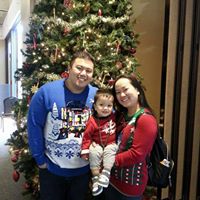Richard Hoang Tran
age ~58
from Manteca, CA
- Also known as:
-
- Richard H Tran
- Richard Tan Tran
- Richard Tran Hoang
- Richard Hoangtran
- Ri Tran
- Tran Cu
- Fan Sports
Richard Tran Phones & Addresses
- Manteca, CA
- Modesto, CA
- Lathrop, CA
- 2834 Buena Knoll Ct, San Jose, CA 95121
- 282 Kenbrook Cir, San Jose, CA 95111
- Fresno, CA
- Milpitas, CA
- San Joaquin, CA
Medicine Doctors

Richard T. Tran
view sourceSpecialties:
Pediatrics, Adolescent Medicine
Work:
Albert & Austein MDsOlney Pediatrics
18111 Prince Philip Dr STE 311, Olney, MD 20832
3017744100 (phone), 3017747648 (fax)
18111 Prince Philip Dr STE 311, Olney, MD 20832
3017744100 (phone), 3017747648 (fax)
Education:
Medical School
Pennsylvania State University College of Medicine
Graduated: 2010
Pennsylvania State University College of Medicine
Graduated: 2010
Procedures:
Hearing Evaluation
Psychological and Neuropsychological Tests
Vaccine Administration
Psychological and Neuropsychological Tests
Vaccine Administration
Conditions:
Acute Pharyngitis
Acute Upper Respiratory Tract Infections
Attention Deficit Disorder (ADD)
Chronic Sinusitis
Plantar Warts
Acute Upper Respiratory Tract Infections
Attention Deficit Disorder (ADD)
Chronic Sinusitis
Plantar Warts
Languages:
English
Spanish
Spanish
Description:
Dr. Tran graduated from the Pennsylvania State University College of Medicine in 2010. He works in Olney, MD and specializes in Pediatrics and Adolescent Medicine. Dr. Tran is affiliated with Medstar Montgomery Medical Center.

Richard Tran
view sourceSpecialties:
Radiology
Vascular & Interventional Radiology
Surgery
Vascular & Interventional Radiology
Surgery
Education:
Tufts University (1993)

Richard Tung-Trong Tran
view sourceName / Title
Company / Classification
Phones & Addresses
Owner
Fresno 1 Hour Photo
Photofinishing Laboratory
Photofinishing Laboratory
2314 N Fresno St, Fresno, CA 93703
Managing
Option Tactical, LLC
Manager
Posh Bagel, Inc
Ret & Whol Bakery
Ret & Whol Bakery
125 W Main St, Los Gatos, CA 95030
228 Cosgrove Ave, Chapel Hill, NC 27514
4083951386
228 Cosgrove Ave, Chapel Hill, NC 27514
4083951386
Office Manager
Sunny Tools and Garden Supply
Whol Hardware Ret Nursery/Garden Supplies
Whol Hardware Ret Nursery/Garden Supplies
580 Parrott St, San Jose, CA 95112
4082781800
4082781800
Resumes

Richard Tran Visalia, CA
view sourceWork:
Western MFG. Corp
2011 to 2012
Computer Technician/Network Administrator Mid City Solar
2009 to 2011
Network Systems Administrator College of the Sequoias Computer Electronics Technology Club
2007 to 2009
2011 to 2012
Computer Technician/Network Administrator Mid City Solar
2009 to 2011
Network Systems Administrator College of the Sequoias Computer Electronics Technology Club
2007 to 2009
Education:
California State University
2009 to 2011
Bachelors of Science in Industrial Technology Network Systems Administration College of the Sequoias
2007 to 2009
Associates of Science De Anza Community College
Cupertino, CA
2003 to 2007
Certificate College of the Sequoias
General Ed
2009 to 2011
Bachelors of Science in Industrial Technology Network Systems Administration College of the Sequoias
2007 to 2009
Associates of Science De Anza Community College
Cupertino, CA
2003 to 2007
Certificate College of the Sequoias
General Ed

Richard Tran San Jose, CA
view sourceWork:
Bay Area Tech Workers for Cisco Systems, Inc
Apr 2011 to 2000
Deal Support Specialist (Data Analyst) TrustHop, Inc
Oct 2010 to Apr 2011
Hired and left as a Business Development Manager Bank of America, Inc
May 2006 to Oct 2010
AVP - Premier Client Manager, left as AVP - Banking Center Manager II
Apr 2011 to 2000
Deal Support Specialist (Data Analyst) TrustHop, Inc
Oct 2010 to Apr 2011
Hired and left as a Business Development Manager Bank of America, Inc
May 2006 to Oct 2010
AVP - Premier Client Manager, left as AVP - Banking Center Manager II
Education:
University of Arizona
Dec 2004 to Dec 2008
BS in Business
Dec 2004 to Dec 2008
BS in Business
Skills:
Microsoft Outlook, Microsoft Office ( Excel, Access, Word, PowerPoint), Microsoft Windows
Vehicle Records
-
Richard Tran
view source -
Address:1753 Erinbrook Pl, San Jose, CA 95131
-
VIN:WVWED7AJ3AW274141
-
Make:VOLKSWAGEN
-
Model:GTI
-
Year:2010
License Records
Richard Tran
License #:
PTC.015955 - Expired
Issued Date:
Jan 26, 2010
Expiration Date:
Jul 25, 2011
Type:
Pharmacy Technician Candidate
Us Patents
-
Structured Large Object (Lob) Data
view source -
US Patent:20130246394, Sep 19, 2013
-
Filed:Mar 13, 2012
-
Appl. No.:13/418771
-
Inventors:Kyle J. Charlet - Morgan Hill CA, US
Nathan D. Church - San Jose CA, US
Kevin D. Hite - San Jose CA, US
Christopher M. Holtz - San Jose CA, US
Richard V. Tran - San Jose CA, US -
Assignee:INTERNATIONAL BUSINESS MACHINES CORPORATION - Armonk NY
-
International Classification:G06F 17/30
-
US Classification:707722, 707E17014
-
Abstract:Provided are techniques for processing structured content within Large Object (LOB) data that is stored in a column of a database table. Structural metadata describing structures that each define a different format of the structured content is stored. A request for data in the database table is received. The structural metadata is used to create an empty result set with columns defined by at least two of the structures. For each row of data in the database table that includes LOB data, control data is used to identify one of the structures to be applied to the structured content within the LOB data stored in that row of data, and the structured content within the LOB data in that row of data is mapped to the columns in the result set based on the identified one of the structures. The result set is returned.
-
Structured Large Object (Lob) Data
view source -
US Patent:20130246395, Sep 19, 2013
-
Filed:Apr 11, 2012
-
Appl. No.:13/444698
-
Inventors:Kyle J. Charlet - Morgan Hill CA, US
Nathan D. Church - San Jose CA, US
Kevin D. Hite - San Jose CA, US
Christopher M. Holtz - San Jose CA, US
Richard V. Tran - San Jose CA, US -
Assignee:INTERNATIONAL BUSINESS MACHINES CORPORATION - Armonk NY
-
International Classification:G06F 17/30
-
US Classification:707722, 707E17014
-
Abstract:Provided are techniques for processing structured content within Large Object (LOB) data that is stored in a column of a database table. Structural metadata describing structures that each define a different format of the structured content is stored. A request for data in the database table is received. The structural metadata is used to create an empty result set with columns defined by at least two of the structures. For each row of data in the database table that includes LOB data, control data is used to identify one of the structures to be applied to the structured content within the LOB data stored in that row of data, and the structured content within the LOB data in that row of data is mapped to the columns in the result set based on the identified one of the structures. The result set is returned.
-
Rating And Notifying Volunteer Responders
view source -
US Patent:20200118233, Apr 16, 2020
-
Filed:Oct 10, 2018
-
Appl. No.:16/155967
-
Inventors:- Armonk NY, US
KEVIN D. HITE - MORGAN HILL CA, US
RICHARD V. TRAN - SAN JOSE CA, US -
International Classification:G06Q 50/26
G06Q 10/06
H04M 1/725
H04W 4/02
H04W 4/029
H04W 4/90 -
Abstract:Examples of techniques for rating and notifying volunteer responders are disclosed. Aspects include receiving a notification of a medical emergency at a first location and obtaining a plurality of candidate volunteer responders from a volunteer responder database. Aspects also include ranking the plurality of candidate volunteer responders based on a location of each of the plurality of candidate volunteer responders, a type of the medical emergency, and a characteristic of each of the plurality of candidate volunteer responders. Aspects further include notifying a highest ranked candidate volunteer from the plurality of candidate volunteer responders of the medical emergency, wherein the notification includes the type of the medical emergency and the first location.
-
Binary Large Object Platform For Interactively Analyzing And Editing Structural Metadata
view source -
US Patent:20200104386, Apr 2, 2020
-
Filed:Sep 27, 2018
-
Appl. No.:16/143690
-
Inventors:- Armonk NY, US
Nathan D. Church - San Jose CA, US
Kevin D. Hite - Morgan Hill CA, US
Richard V. Tran - San Jose CA, US -
International Classification:G06F 17/30
G06F 9/54
G06F 11/07 -
Abstract:Embodiments include methods, systems and computer program products method for editing and correcting structural metadata associated a binary large object (BLOB). The computer-implemented method includes obtaining, using a processor, at least a portion of structural metadata associated with the BLOB. The processor converts one or more fields associated with the at least a portion of structural metadata and determines that the one or more fields generated one or more errors or null values. The processor provides an interface, wherein the interface is used to cause a first movement or edit the one or more fields. The processor determines that the first movement or edit of the one or more fields fixes the one or more errors or null values and provides an indication that the first movement or edit of the one or more fields has or has not fixed the one or more errors or null values.
-
Generating Instructional Variants Based On Natural Language Processing Of Comments Feed
view source -
US Patent:20200073935, Mar 5, 2020
-
Filed:Aug 31, 2018
-
Appl. No.:16/118867
-
Inventors:- ARMONK NY, US
Richard V. Tran - San Jose CA, US -
International Classification:G06F 17/27
G06N 99/00
G06N 5/04
G09B 19/00 -
Abstract:A method, computer system, and a computer program product for generating an instructional variant is provided. The present invention may include identifying an instructional guide. The present invention may also include analyzing a user comments feed associated with the identified instructional guide. The present invention may further include, in response to determining that the analyzed user comments feed includes a modification to the identified instructional guide, generating a variant instructional guide including the modification to the identified instructional guide.
-
Dynamically Adding Custom Data Definition Language Syntax To A Database Management System
view source -
US Patent:20180293263, Oct 11, 2018
-
Filed:Apr 10, 2017
-
Appl. No.:15/482918
-
Inventors:- ARMONK NY, US
Kevin D. Hite - San Jose CA, US
Richard V. Tran - San Jose CA, US -
International Classification:G06F 17/30
-
Abstract:A computer-implemented method includes receiving, via original Data Definition Language (DDL) syntax of a Database Management System (DBMS), a definition of custom DDL syntax. Metadata describing the custom DDL syntax is stored in a global catalog of the DBMS. A first DDL statement that utilizes the custom DDL syntax is received. The metadata describing the custom DDL syntax is read from the global catalog. The first DDL statement is processed, using a computer processor, according to the metadata.
-
Interpreting Invalid Data As Valid Data
view source -
US Patent:20160171026, Jun 16, 2016
-
Filed:Dec 11, 2014
-
Appl. No.:14/567163
-
Inventors:- Armonk NY, US
Kevin D. Hite - San Jose CA, US
Richard V. Tran - San Jose CA, US -
International Classification:G06F 17/30
-
Abstract:Provided are techniques for interpreting invalid data that is a portion of a data set as valid data. A request is received to convert data from a first format to a second format for an application, wherein the data is a portion of a data set. It is determined that the data is invalid, wherein the invalid data cannot be processed by the application in the first format. It is determined whether the invalid data is to be interpreted as valid based on a flag. In response to determining that the invalid data is to be interpreted as valid, setting the invalid data to a new value in the second format that can be processed by the application.
-
Interpreting Invalid Data As Valid Data
view source -
US Patent:20160171066, Jun 16, 2016
-
Filed:Aug 20, 2015
-
Appl. No.:14/831506
-
Inventors:- Armonk NY, US
Kevin D. Hite - San Jose CA, US
Richard V. Tran - San Jose CA, US -
International Classification:G06F 17/30
-
Abstract:Provided are techniques for interpreting invalid data that is a portion of a data set as valid data. A request is received to convert data from a first format to a second format for an application, wherein the data is a portion of a data set. It is determined that the data is invalid, wherein the invalid data cannot be processed by the application in the first format. It is determined whether the invalid data is to be interpreted as valid based on a flag. In response to determining that the invalid data is to be interpreted as valid, setting the invalid data to a new value in the second format that can be processed by the application.

Richard Luu Tran
view source
Richard Tran
view source
Richard IHoop Tran
view source
Richard Tran Mills
view source
Richard Tran Van Thanh
view source
Richard Tran
view source
Richard Tien Tran
view source
Richard Huy Tran
view sourceYoutube
Plaxo

Richard Tran
view sourceVeriFone
Classmates

Richard Tran
view sourceSchools:
Legacy High School Broomfield CO 2000-2004
Community:
Christopher Garman, Joshua Brown, Mark Mounsey

Richard Tran
view sourceSchools:
Monroe Elementary School Oklahoma City OK 1990-1995
Community:
Harry Wilson, Alma Salazar, Angeline Cook, April Carter, Jairo Campos, Bradley Preston, Meredith King

Marshall Pomeroy Elementa...
view sourceGraduates:
Richard Tran (1996-1997),
Trisha Reyes (1977-1983),
Tinamarie Mendiola (1975-1981)
Trisha Reyes (1977-1983),
Tinamarie Mendiola (1975-1981)

Thomas Russell Middle Sch...
view sourceGraduates:
Richard Tran (1997-1999),
Heather Rader (1958-1965)
Heather Rader (1958-1965)

Robert Randall Elementary...
view sourceGraduates:
Gretchen Steinwandt (1980-1982),
Carol Inman (1972-1976),
Nancy Chan (1990-1995),
Richard Tran (1994-1996)
Carol Inman (1972-1976),
Nancy Chan (1990-1995),
Richard Tran (1994-1996)

Clear Lake High School, H...
view sourceGraduates:
Lisa Richard (1970-1974),
Ashton Jackson III (1989-1993),
Richard Tran (1997-2001)
Ashton Jackson III (1989-1993),
Richard Tran (1997-2001)

Legacy High School, Broom...
view sourceGraduates:
Richard Tran (2000-2004),
Christina Knudsen (1999-2003),
Ashly Stearns (2004-2008),
Emily Seto (2005-2009),
Michael Bralish (1999-2003)
Christina Knudsen (1999-2003),
Ashly Stearns (2004-2008),
Emily Seto (2005-2009),
Michael Bralish (1999-2003)
Myspace
Flickr
Googleplus

Richard Tran
Lived:
San Jose, CA
Tucson, AZ
Apopka, FL
Tucson, AZ
Apopka, FL
Work:
Cisco Systems, Inc. - Business Analyst (2010)

Richard Tran
Work:
Simply Wireless - Call Center Rep (2011)
Borders Group - Cashier (2010-2011)
Borders Group - Cashier (2010-2011)
Education:
Northern Virginia Community College - Biology

Richard Tran
Work:
Starbucks - Assistant Manager (2004)
Education:
California State University, Long Beach - Interpersonal & Organizational Communication Studies
Tagline:
Knowledge is invaluable, unless it's put into use.

Richard Tran
Education:
Jefferson High
About:
I'm a Loner, I don't care. /Trollface
Tagline:
Hai. No don't look at me.
Bragging Rights:
Don't have one. Think of one for me.

Richard Tran
Education:
Oakton Community College, Von steuben

Richard Tran
Education:
University of California, Berkeley - Business Administration

Richard Tran
Education:
University of California, Berkeley

Richard Tran
Work:
ST6IX
Get Report for Richard Hoang Tran from Manteca, CA, age ~58





















